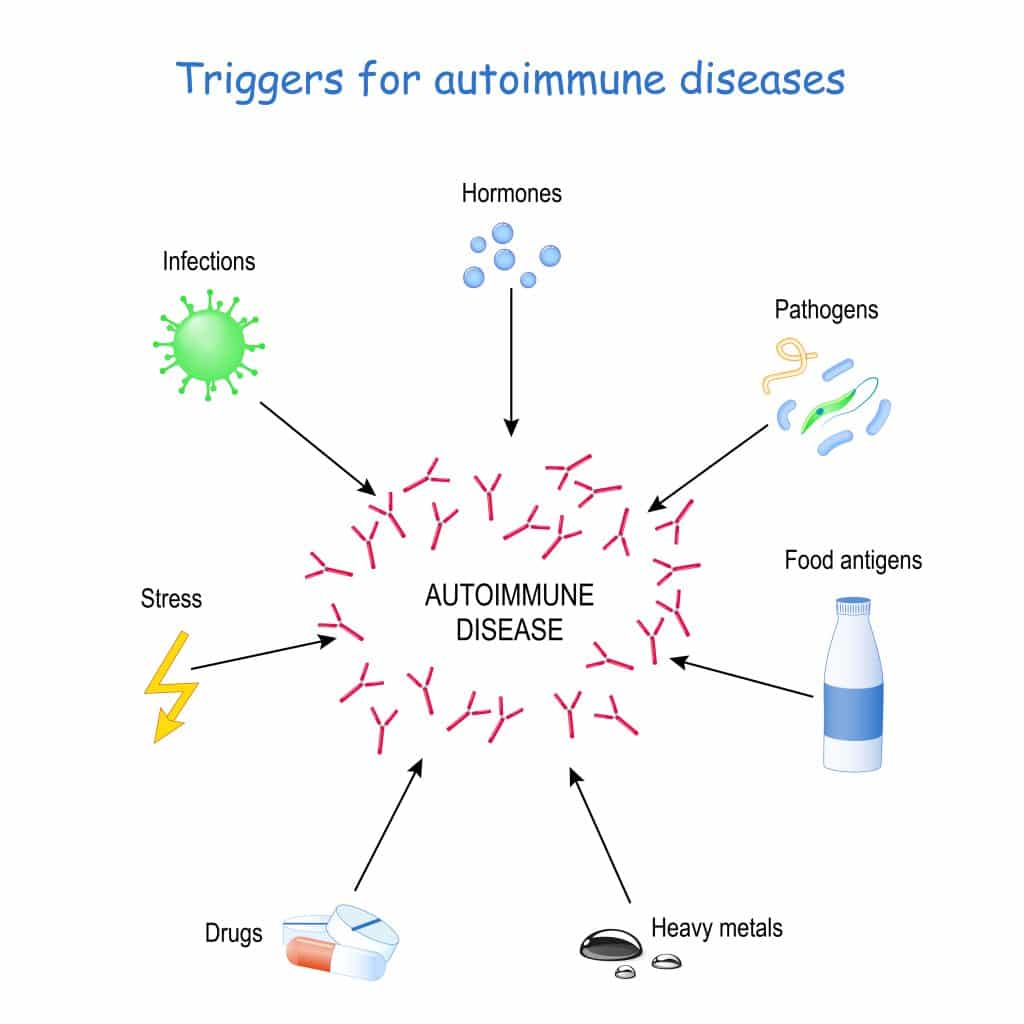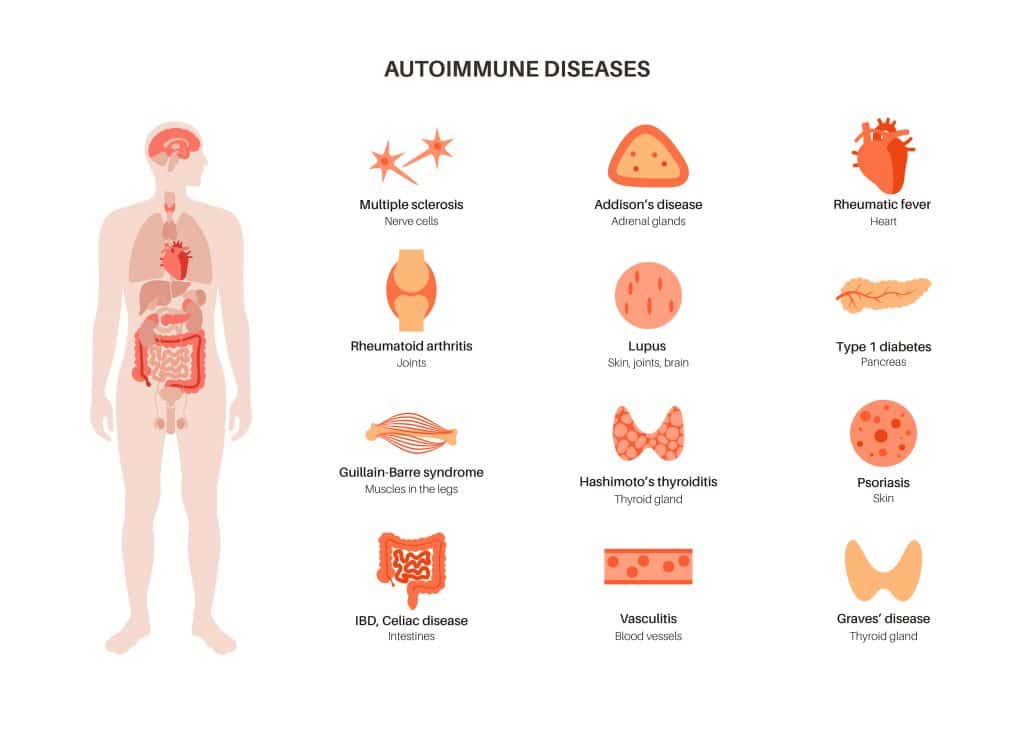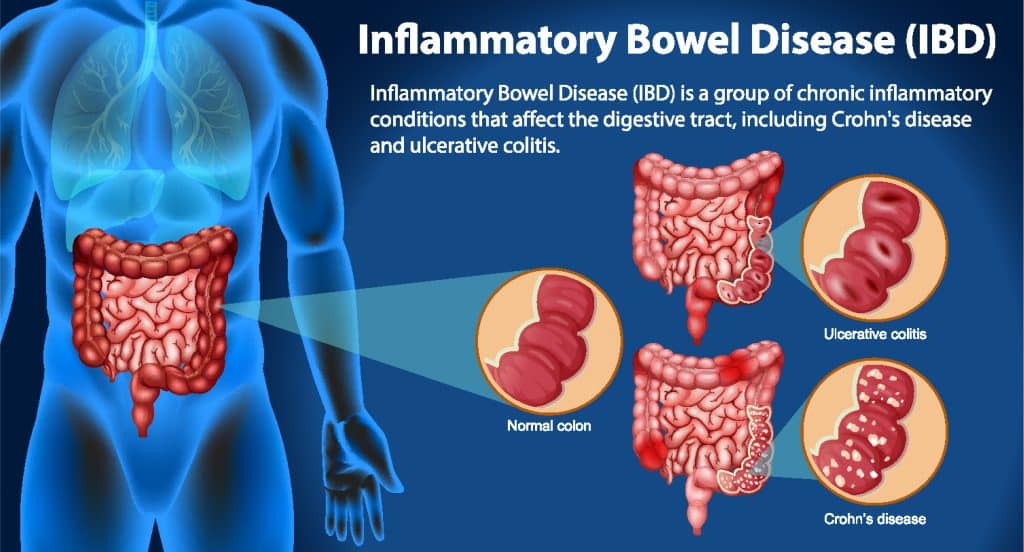A Look At Autoimmune Diseases And Associated Risk Factors
Autoimmune diseases are a group of disorders in which the body’s immune system mistakenly attacks its own healthy cells and tissues, causing damage and inflammation. This can lead to a wide range of symptoms and complications, affecting different parts of the body. A combination of genetic predisposition, environmental factors, and microbiome dysfunction all play a role in the development of autoimmune diseases.
Lifestyle And Environmental Factors Behind Autoimmune Diseases
There is growing research on the role of diet and lifestyle in managing autoimmune diseases. Certain foods have been found to trigger inflammation and worsen symptoms. On the other hand, a healthy diet and exercise have been shown to improve overall health in individuals with autoimmune diseases.1
In addition to diet and exercise, stress management techniques such as meditation, yoga, and therapy can also greatly benefit those living with autoimmune conditions. Stress has been linked to inflammation and can exacerbate symptoms of autoimmune diseases. Finding ways to reduce stress levels through relaxation techniques can help improve overall health and well-being.2
Moreover, getting enough sleep is essential for managing autoimmune diseases. Lack of sleep has been linked to increased inflammation and a weakened immune system. Individuals with autoimmune diseases should prioritize getting at least 7-9 hours of quality sleep each night. Establishing a regular bedtime routine and avoiding screens before bed can greatly improve sleep quality.3
Environmental factors such as exposure to toxins, pollutants, and chemicals can also increase the risk of developing autoimmune diseases.4 For example, exposure to cigarette smoke has been linked to the development of multiple sclerosis (MS), while exposure to silica dust has been associated with an increased risk of developing rheumatoid arthritis.5 6 Additionally, exposure to certain chemicals and heavy metals, such as mercury and lead, have been linked to the development of autoimmune conditions.7 8
Read more about toxins associated with autoimmune conditions.

Common Symptoms Of Autoimmune Diseases
Symptoms of autoimmune diseases can vary greatly depending on the specific disease and affected organs. They can range from mild to severe and may include fatigue, joint pain, skin rashes, digestive issues, and neurological problems.9
People with autoimmune disorders can experience extreme fatigue, even after getting enough rest. This is due to the overactivity of the immune system, which causes inflammation and affects energy levels.10
Many autoimmune disorders cause joint pain and stiffness, such as rheumatoid arthritis or lupus. This is because the immune system attacks the body’s own tissues, including the joints.11
Certain autoimmune disorders can cause skin rashes and other dermatological symptoms. For example, psoriasis is an autoimmune disorder that causes red, scaly patches on the skin.12
Autoimmune disorders can also affect the digestive system, leading to symptoms such as abdominal pain, bloating, diarrhea, or constipation. This is because the immune system can attack and damage the lining of the digestive tract.13
A low-grade fever is a common symptom of many autoimmune disorders, as it is a sign of inflammation and immune system activity. However, some autoimmune disorders may also cause high fevers in certain individuals.14
While these are some of the most common symptoms, it’s important to remember that symptoms can vary greatly depending on the type of autoimmune disorder and the individual. Some people may experience a combination of these symptoms, while others may only have one or two. Additionally, some autoimmune disorders may present with other symptoms not listed here, such as hair loss or neurological issues.

A Look At Autoimmune Diseases – Rheumatoid Arthritis
Rheumatoid arthritis (RA) is an inflammatory condition that affects the joints. It occurs when the immune system attacks the lining of the joints, causing pain, stiffness, and swelling. RA is more common in women than men and typically develops between the ages of 40 to 60.15
Read more about Rheumatoid Arthritis.
A Look At Autoimmune Diseases – Systemic Lupus Erythematosus
Systemic lupus erythematosus (SLE) is a chronic autoimmune disease that can affect various parts of the body, including the skin, joints, kidneys, and other organs. Symptoms may vary from person to person but often include joint pain, fatigue, and a butterfly-shaped rash on the face. SLE more commonly affects women than men.16
Read more about Systemic Lupus Erythematosus.
A Look At Autoimmune Diseases – Multiple Sclerosis
Multiple sclerosis (MS) is a neurological condition that affects the central nervous system. It occurs when the immune system attacks the protective covering of nerve cells, leading to inflammation and damage. Symptoms may include fatigue, numbness or weakness in limbs, and difficulty with coordination and balance. MS is more common in women than men.18
Read more about Multiple Sclerosis.

A Look At Autoimmune Diseases – Psoriasis
Psoriasis is a chronic autoimmune condition that causes an overproduction of skin cells, resulting in red, scaly patches on the skin. It can also affect the joints, leading to a condition known as psoriatic arthritis. Psoriasis affects approximately 2% of the population and can occur at any age.19
Read more about Psoriasis.
A Look At Autoimmune Diseases – Celiac Disease
Celiac disease is an autoimmune disorder where the immune system reacts to gluten, a protein found in wheat, barley, and rye. This reaction damages the small intestine and can lead to malabsorption of nutrients. Celiac disease is commonly diagnosed in childhood, but it can develop at any age.20
Read more about Celiac Disease.
A Look At Autoimmune Diseases – Inflammatory Bowel Disease
Inflammatory Bowel Disease (IBD) is one such autoimmune disease that affects the gastrointestinal tract. There are two main types of IBD – Crohn’s disease and ulcerative colitis. Both conditions cause chronic inflammation in the digestive tract, leading to symptoms such as abdominal pain, diarrhea, and rectal bleeding. However, the two diseases have distinct characteristics and affect different parts of the digestive tract.
Crohn’s disease can affect any part of the gastrointestinal tract, from the mouth to the anus. The inflammation caused by Crohn’s disease often spreads deep into the layers of affected bowel tissue, resulting in complications such as fistulas and strictures. Ulcerative colitis, on the other hand, affects only the colon and rectum and typically causes continuous inflammation along the inner lining of these organs.21
Read more about Inflammatory Bowel Disease.

A Look At Autoimmune Diseases – Graves’ Disease
Graves’ disease is an autoimmune disorder that affects the thyroid gland, a small butterfly-shaped gland located in the neck. This condition causes the thyroid gland to produce excessive amounts of hormones, resulting in hyperthyroidism or overactive thyroid.22
Read more about Graves’ Disease.
A Look At Autoimmune Diseases – Hashimoto’s Thyroiditis
Hashimoto’s Thyroiditis is an autoimmune disease that specifically targets the thyroid gland. It occurs when the immune system produces antibodies that attack and damage the thyroid tissue, leading to inflammation and disruption of normal thyroid function. Over time, this can lead to hypothyroidism, a condition in which the thyroid gland does not produce enough hormones for the body’s needs.23
Read more about Hashimoto’s Thyroiditis.
A Look At Autoimmune Diseases – Guillain-Barre Syndrome
Guillain-Barre syndrome is a rare autoimmune disorder that affects the peripheral nervous system. It occurs when the immune system attacks healthy nerve cells, causing inflammation and muscle weakness.
The most common symptom of Guillain-Barre syndrome is muscle weakness, which usually starts in the legs and gradually spreads to the arms and upper body. This weakness can progress rapidly and can lead to paralysis in severe cases. Other symptoms may include tingling sensations, changes in sensation or numbness, difficulty moving the eyes, and difficulty with coordination and balance.
In addition to muscle weakness, Guillain-Barre syndrome can also cause respiratory problems. This is because the muscles that control breathing may be affected, leading to difficulty in breathing independently.24
Read more about Guillain-Barre Syndrome.
A Look At Autoimmune Diseases
While these are some of the most common autoimmune disorders, there are many others that affect millions of people worldwide. Some less prevalent autoimmune diseases include Sjogren’s syndrome, Pernicious anemia, myositis, and Myasthenia Gravis.
A Look At Autoimmune Diseases And Associated Risk Factors
To help prevent and manage autoimmune conditions, maintaining a healthy lifestyle is key. This includes eating a balanced diet, getting regular exercise, managing stress levels, and avoiding smoking and excessive alcohol consumption.
If you suspect that you may have an autoimmune condition, keep learning about them and reach out to us so we can help you.
Read more if you think you have an autoimmune condition.
References
1 Mazzucca CB, Raineri D, Cappellano G, Chiocchetti A. How to Tackle the Relationship between Autoimmune Diseases and Diet: Well Begun Is Half-Done. Nutrients. 2021 Nov 5;13(11):3956. doi: 10.3390/nu13113956. PMID: 34836210; PMCID: PMC8620243.
2 Stojanovich L, Marisavljevich D. Stress as a trigger of autoimmune disease. Autoimmun Rev. 2008 Jan;7(3):209-13. doi: 10.1016/j.autrev.2007.11.007. Epub 2007 Nov 29. PMID: 18190880.
3 Zielinski MR, Systrom DM, Rose NR. Fatigue, Sleep, and Autoimmune and Related Disorders. Front Immunol. 2019 Aug 6;10:1827. doi: 10.3389/fimmu.2019.01827. PMID: 31447842; PMCID: PMC6691096.
4 Kharrazian D. Exposure to Environmental Toxins and Autoimmune Conditions. Integr Med (Encinitas). 2021 Apr;20(2):20-24. PMID: 34377090; PMCID: PMC8325494.
5 Nishanth K, Tariq E, Nzvere FP, Miqdad M, Cancarevic I. Role of Smoking in the Pathogenesis of Multiple Sclerosis: A Review Article. Cureus. 2020 Aug 5;12(8):e9564. doi: 10.7759/cureus.9564. PMID: 32905534; PMCID: PMC7473606.
6 Wrangel O, Graff P, Bryngelsson IL, Fornander L, Wiebert P, Vihlborg P. Silica Dust Exposure Increases Risk for Rheumatoid Arthritis: A Swedish National Registry Case-Control Study. J Occup Environ Med. 2021 Nov 1;63(11):951-955. doi: 10.1097/JOM.0000000000002281. PMID: 34091575; PMCID: PMC8562940.
7 Pollard KM, Cauvi DM, Toomey CB, Hultman P, Kono DH. Mercury-induced inflammation and autoimmunity. Biochim Biophys Acta Gen Subj. 2019 Dec;1863(12):129299. doi: 10.1016/j.bbagen.2019.02.001. Epub 2019 Feb 10. PMID: 30742953; PMCID: PMC6689266.
8 Mishra KP. Lead exposure and its impact on immune system: a review. Toxicol In Vitro. 2009 Sep;23(6):969-72. doi: 10.1016/j.tiv.2009.06.014. Epub 2009 Jun 18. PMID: 19540334.
9 Autoimmune disease: Why is my immune system attacking itself? (2021, November 10). Johns Hopkins Medicine. https://www.hopkinsmedicine.org/health/wellness-and-prevention/autoimmune-disease-why-is-my-immune-system-attacking-itself
10 Alekseeva TM, Kreis OA, Gavrilov YV, Valko PO, Weber KP, Valko Y. Impact of autoimmune comorbidity on fatigue, sleepiness and mood in myasthenia gravis. J Neurol. 2019 Aug;266(8):2027-2034. doi: 10.1007/s00415-019-09374-1. Epub 2019 May 21. PMID: 31115673.
11 Mifflin KA, Kerr BJ. Pain in autoimmune disorders. J Neurosci Res. 2017 Jun;95(6):1282-1294. doi: 10.1002/jnr.23844. Epub 2016 Jul 22. PMID: 27448322.
12 Ávalos-Díaz E, Herrera Esparza R. Dermatological autoimmune diseases. In: Anaya JM, Shoenfeld Y, Rojas-Villarraga A, et al., editors. Autoimmunity: From Bench to Bedside [Internet]. Bogota (Colombia): El Rosario University Press; 2013 Jul 18. Chapter 34. Available from: https://www.ncbi.nlm.nih.gov/books/NBK459479/
13 Cojocaru M, Cojocaru IM, Silosi I, Vrabie CD. Gastrointestinal manifestations in systemic autoimmune diseases. Maedica (Bucur). 2011 Jan;6(1):45-51. PMID: 21977190; PMCID: PMC3150032.
14 Kallinich T, Gattorno M, Grattan CE, de Koning HD, Traidl-Hoffmann C, Feist E, Krause K, Lipsker D, Navarini AA, Maurer M, Lachmann HJ, Simon A. Unexplained recurrent fever: when is autoinflammation the explanation? Allergy. 2013 Mar;68(3):285-96. doi: 10.1111/all.12084. Epub 2013 Jan 18. PMID: 23330689.
15 Rheumatoid arthritis – Symptoms and causes. (2023, January 25). Mayo Clinic. https://www.mayoclinic.org/diseases-conditions/rheumatoid-arthritis/symptoms-causes/syc-20353648
16 Lupus symptoms | Lupus Foundation of America. (2023). Lupus Foundation of America. https://www.lupus.org/resources/common-symptoms-of-lupus
17 What Is Type 1 Diabetes? (2022, March 11). Centers for Disease Control and Prevention.
18 Dobson R, Giovannoni G. Multiple sclerosis – a review. Eur J Neurol. 2019 Jan;26(1):27-40. doi: 10.1111/ene.13819. Epub 2018 Nov 18. PMID: 30300457.
19 Kimmel GW, Lebwohl M. Psoriasis: Overview and Diagnosis. Evidence-Based Psoriasis. 2018 Jul 1:1–16. doi: 10.1007/978-3-319-90107-7_1. PMCID: PMC7122924.
20 Celiac Disease. (2023). Johns Hopkins Medicine. https://www.hopkinsmedicine.org/health/conditions-and-diseases/celiac-disease
21 What is inflammatory bowel disease (IBD)? | IBD. (2022). https://www.cdc.gov/ibd/what-is-ibd.htm
22 Graves’ disease – Symptoms and causes – Mayo Clinic. (2022, June 14). Mayo Clinic. https://www.mayoclinic.org/diseases-conditions/graves-disease/symptoms-causes/syc-20356240
23 American Thyroid Association. (2020b, June 8). Hashimoto’s Thyroiditis | American Thyroid Association. https://www.thyroid.org/hashimotos-thyroiditis/
24 Nguyen TP, Taylor RS. Guillain-Barre Syndrome. [Updated 2023 Feb 7]. In: StatPearls [Internet]. Treasure Island (FL): StatPearls Publishing; 2023 Jan-. Available from: https://www.ncbi.nlm.nih.gov/books/NBK532254/




